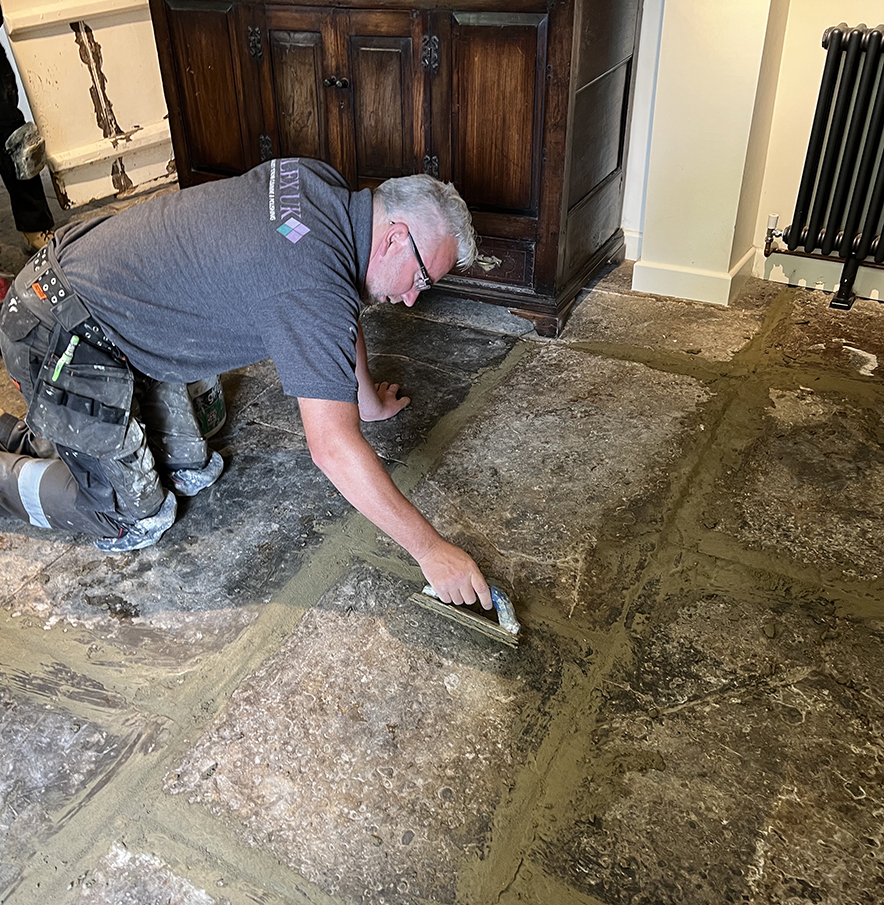How an historic blue lias floor is brought back to life without losing its historical reference
Part of the beauty of stone is that it just looks better as it ages. But it can benefit from a helping hand to keep it looking its best.
In this case study, we visit a Blue Lias flooring renovation project and discuss the work out by stone maintenance specialist Silex UK using the products of manufacturer LTP.
Original flagstones are a beautiful feature in a period property, but keeping the stones looking their best can be helped by an occasional clean and sympathetic treatment.
In many cases, stones in old properties are laid directly onto the ground, with no damp-proof membrane underneath. This installation method allowed the stone to ‘breathe’, absorbing and evaporating moisture freely through the its natural porosity.
For a successful renovation, it is essential that this ability to ‘breathe’ is not compromised. That means using the correct treatments and methods.
About Blue Lias limestone
The sediments that form the basis of Blue Lias limestone were deposited in the late Triassic and early Jurassic geolical periods, some 195-200 million years ago. The resulting stone gets its name from the quarrymen’s dialect for layers – ‘lias’. The stone is made up of layers of limestone and shale. It has a distinct blue/grey tinge due to its fossils, ores and iron content. It is mainly found in Somerset and Dorset.
Renovation cleaning
In a Grade II Listed property in Sparkford, near Castle Carey in Somerset, around 100m2 of Blue Lias has been laid when the house was built. It formed the floor in an area that includes the side entrance, kitchen and a narrow corridor leading into the main open hall area, including the dining area and lounge.
LTP advised the Silex UK team on the best cleaning and protection method, in view of the stone’s age and environment.
Being in a historic installation, the floor was laid directly on to the earth, without a damp-proof membrane.
Before the floor was cleaned, Alastair Niddrie from Silex UK carefully removed salts, flaky residue and paint deposits by hand using LTP Grimex to clean the limestone and remove greasy residue.
Grimex is an intensive cleaner that removes oil, grease, ingrained dirt, water-based paint and old layers of wax.
It is safe to use on all types of natural stone and it can be used at different dilutions to suit the particular project.
Alastair used a 1:3 dilution, applying the cleaner to the flagstones with a broad brush. The treatment was left to react for 5-10minutes, during which time the floor was kept wet with additional solution. It was then agitated with a brush, residue was removed and the surface was rinsed thoroughly with clean water.
LTP Solvex – an intensive cleaner/stripper – can be used alongside Grimex to remove oil-based paint, wax, oil, silicone, acrylic, polyurethane sealer and residual epoxy grout. Like Grimex, it is safe to use on natural stone.
Phase II – protection
Flagstone floors are often enhanced and protected using wax-based treatments, but this is only suitable for a floor laid above a damp-proof membrane and should not be used on a floor without such a membrane as it seals the stone and prevents the passage of moisture and salts through it.
If the stone is not able to ‘breathe’ it will eventually break up. Walls can also be compromised as moisture looks for other ways to escape.
At the privately-owned property that is the subject of this case study, Silex used LTP’s Ecoprotec Colour Enhancing Stone Sealer, a water-based non-film forming impregnating treatment that enhances the surface as well as protecting it from water, oil and grease spilled on to it, while allowing moisture from below that permeates the stone to escape. It also helps to reduce efflorescence.
The first coat was applied after the stone had dried out from the intensive cleaning (after about 24 hours) and before re-pointing. A further coat was applied 24 hours after the stone had been re-grouted and any residual grout had been removed, the final coat covering the re-pointed joints as well.
To ensure a good application into the uneven surface, Alastair applied the treatment with a broad paint brush. Once cured, the floors were buffed using a rotary machine fitted with white pads to give the surface a beautiful lustre. The flagstones were then polished by hand with woollen pads.

